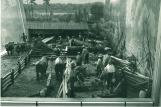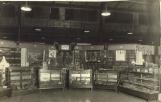1
Portrait of Wilf and Amoscirca 1940
Lobo Township, Middlesex County, Ontario, Canada
 Credits:
Credits:Museum of Ontario Archaeology
2
In the early 1920s Amos and Wilf had a small collection of Native artifacts, consisting mostly of items they themselves had found on the surface while cultivating fields and of pieces given to them by neighbors. At the end of 1924 their collection had only 75 catalogued artifacts, but that number begam to multiply exponentially when in 1925 they started to excavate at local camp and village sites. It so happened that the Jury homestead was situated in a rich archaeological area. The combination of slightly rolling terrain of sandy loam soils bisected by meandering tributaries flowing into the Thames River created optimal conditions for Native land use and habitation. Indeed, we now know that the central portion of Middlesex County encompassed by Caradoc, Lobo and London Townships had been inhabited by Ontario's aboriginal peoples from approximately 9,000 B.C. throught to 1500 A.D. There are prehistoric camp sites and villages scattered all across the area, and it was at some of these that Amos and Wilf first excavated. Some of their earliest excavations were just a short walk away on their neighbor's farms, such as the Edwards, Drumholm, and Alway sites. Later, they expanded their search to sites lying within a 60 mile radius of home.4
There were some remarkable developments in the late 1920s. The Jury collection had grown to such an extent that it was featured in local newspaper articles and in a major story in The Farmer's Advocate (July 18, 1928). Wilf's own articles were published in the London Free Press and London Advertiser. Amos and Wilf began to display their collection at the annual Western Fair. These displays were soon augmented by Amos' carefully crafted models, and the Jurys' later created massive exhibits for the Stratford Fair. There were rumblings about the need for a formal museum in the City of London, possibly one to be created at the University of Western Ontario based on the Jury collection. Throughout this time Amos and Wilf continued their fieldwork. As more people heard about the collection or saw it on display, more and more donations were made to supplement their growing collection.5
Amos and Wilf's exhibit at the Western Faircirca 1931
London, Ontario, Canada
 Credits:
Credits:Museum of Ontario Archaeology
6
In the early 1930s Amos and Wilf continued with their annual Fair displays. Each year they improved it by adding new elements including models. At this time there were some initial conversations between the Jurys and University of Western Ontario personnel, principally President W. Sherwood Fox. and Librarian/historian Fred Landon, about the possible museum. These discussions evolved into formal deliberations in 1932-1933, and a plan was conceived for Amos and Wilf to donate their collection to the University.7
A model created by Amoscirca 1931
Lobo Township, Middlesex County, Ontario, Canada
 Credits:
Credits:Museum of Ontario Archaeology
